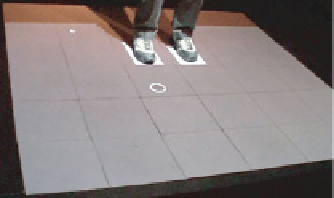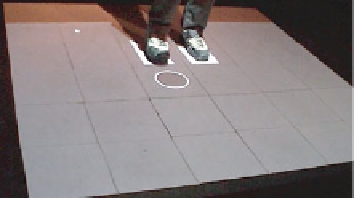Biomedical Engineering Reference
In-Depth Information
Bearing angle
Distance
Width
Width (Distance < 45 cm)
.99
.99
.97
1.0
.94
.94
.83
.84
.84
.78
.79
.77
0.8
.66
.61
.58
0.6
.53
.44
0.4
0.2
0.0
π/3
2π/3
15
25
35
45
4.5
7.5 10.5 13.5 16.5
4.5
7.5 10.5 13.5
16.5
radians
cm
cm
cm
Fig. 17.13
To p ro w
a user in the study of Visell et al. [
39
], in which circular targets were selected
via stepping actions.
Bottom
successful target selection rate versus distance, angle of presentation
(measured away from preferred foot), and button width, inclusive and exclusive of the farthest
targets
Six out of eight participants in this study reported finding a strategy to activate
the small buttons by using a feature of the shoe or changing the applied force.
Nearby targets (distances of
D
15-25 cm) were selected at a higher rate. However,
performance was better at 25 cm than at the nearest distance of 15 cm (98.5 vs. 84 %).
One apparent reason was that when an interface element was too close, it could be
occluded from view by the body, or could present a difficult viewing angle. Due to
such effects selection time
T
might not be expected to follow a Fitts' Law relation,
T
=
=
+
b
log
2
(
/
)
, but this was not tested. A mobile user might be able to avoid
visibility problems, but they seem to be an important consideration. Neck fatigue
was a frequently cited source of discomfort, suggesting that displacing the visual
feedback relative to the foot-based interaction point might be beneficial.
Further work is needed on the usability of floor surfaces in order to characterize
the usability aspects of floor-based touch-screen displays. A greater understanding
of factors such as control element size, display scale, motor abilities, modalities,
and other aspects salient to the use of such a device will certainly be needed. In
addition, it would be valuable to know to what extent usability might be improved
through the use of auditory or vibrotactile feedback. Although Augsten et al. were
able to identify some strategies that could be used to avoid selecting controls that are
walked across, there remain open questions concerning the interplay between users'
movements on foot and their interactions with the touch surface. A novel aspect of
a
D
W

































